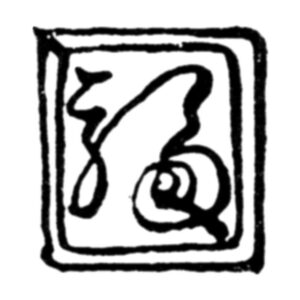
In addition to the engraved seal, there are also written inscriptions and inscriptions. From a developmental standpoint, the need for this type of inscription seems to have arisen around the time when the kiln style was slightly advanced and communal firing began to take place. In other words, when many pieces were fired in the same kiln, they were used to avoid confusion and to make identification easier and more reliable. However, once an inscription appeared, some people used it as a convenience to seek out their favorite craftsman, and this led to the idea that, in addition to the above-mentioned purposes, the kiln mark was where the artist’s individuality existed. A tea utensil that is considered to have the same significance as a painter’s seal.
The same meaning as a painter’s seal is also attached to tea ceremony utensils. In Japan, the first pottery seal was probably made in the late Muromachi period (1336-1573), and relatively early kiln marks include the key seal of Kato Soemon Harunaga and the pine needle seal of Kato Choju in the Seto Rokusaku series selected by Nobunaga in 1563. However, the development of name seals should be seen after the Kyo kilns, and the founder of the Kyo kilns, Ninsei, and others used magnificent name seals. In the Edo period, the first type of inscriptions on pottery was those that indicated the name of the kiln or the famous master of the capital city or euphony. The second type is that which represents a character or form of auspiciousness, such as the character “fuku” in Kutani and Imari, “Banko Fueki” in Mangoku, “Taka” in Ueno, and the form associated with “Soma” in Soma. Third, since ceramics often stand under a certain guardian, there are not a few examples of seals presented by that guardian. The typefaces used are seal, clerical, standard, line, and cursive, but as with most seals, they are seal and standard script, with or without outlines. Some are enclosed in complex shapes, such as Dobachi’s conch shells and Yoshimukai’s tortoiseshell shells. The seal is usually placed on the left side of the base, on the back of the lid for incense containers, and on the underside of the hand for kyusu pots. Most of the time, only one seal is used, but there are cases where a series of seals are used, such as “mushiake” and “makazu”. Some kyusu are decorated with seals, for example, dozens of seals are stamped on the entire surface of a kyusu. The materials used for seals varied widely, from gold and silver to copper, iron, stone, and bronze, but wood such as huangyang is said to be the easiest and most convenient to separate when pressed into the earth. In the Orient, the development of the inscription seal is said to have been first in Japan, with few in China, and almost none in Korea. In China, however, there are only a few mass-production kilns, and the development of official kilns since the Ming dynasty (1368-1644) has left most of the country’s pottery production to a single kiln. It can be pointed out that the development of the official kilns after the Ming dynasty was such that almost all the country’s pottery was left to a single kiln, and that the idea was to clarify the date of production rather than the place of production, such as Wanli in the Great Ming dynasty or Qianlong in the Great Qing dynasty. The above is in accordance with Wakimoto Rakunoken’s theory.



